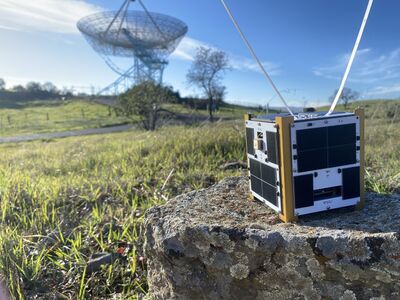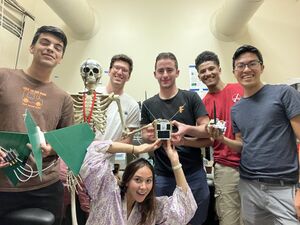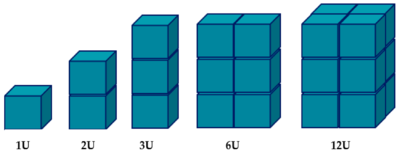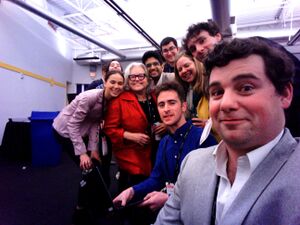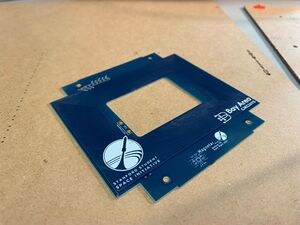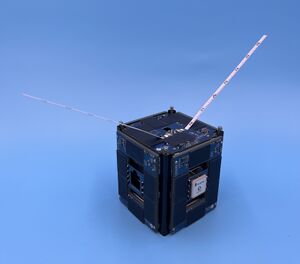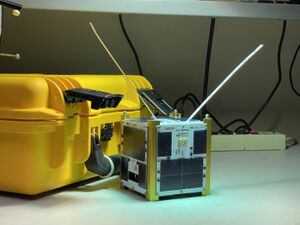Difference between revisions of "Category:Satellites"
| Line 23: | Line 23: | ||
== Satsurdays and Team Meetings == | == Satsurdays and Team Meetings == | ||
| − | We have team-wide meetings '''every Saturday at | + | We have team-wide meetings '''every Saturday at 12pm in [https://maps.app.goo.gl/hj8P2qSLKHK18MRk6 ES3]'''! Satsurdays is a great opportunity to come together as a group and get everyone on the same page, and it's also where we most often make big announcements. In addition to Satsurdays, each of our subteams have weekly meetings which you can find in the Satellites Events Calendar. |
== What is a CubeSat? == | == What is a CubeSat? == | ||
Latest revision as of 21:45, 3 October 2024
Welcome to the SSI Satellites Team! Whether you're an incoming frosh, tired old senior, graduate student, alumni, or even not a part of the Stanford community, we're glad you're here. Our current mission is SAMWISE, a 2U CubeSat set for launch next year that is pushing the boundaries of our team's technological capability. Our Satellite Team Leads are
![]() @Niklas Vainio
@Niklas Vainio ![]() @Sage Wu
@Sage Wu ![]() @Hunter Liu
@Hunter Liu
Satellites Notion 🛰️
This wiki page is not updated frequently - we keep more up-to-date information, including some technical docs, on our Notion Page
Getting Started with Satellites 🛰️
Stanford Affiliated 🌲
If you're a Stanford student, professor, or affiliate we'd love for you to join the Satellites community! For information on joining SSI as a whole, check out the How to Join SSI page.
Once you've joined our Slack messaging hub, you'll be able to join all of our Satellites-specific channels! Definitely join the general satellites channel which is where we'll post all of our major updates and make big announcements. We've also got a lot of subteams, each with their own channel (we love our Slack channels here at SSI). Check out the Subteams section on this page to learn about them and join any channels you find interesting.
And of course if any questions or confusions come up, don't hesitate to reach out to any of the Satellite Team Leads. Also feel free to reach out to Subteam Leads if you have subteam-specific questions!
Outside Stanford
If you're not affiliated with Stanford but are interested in the team and our projects, we'd still love to have you! To get in touch, please email one or all of the team leads (see above).
SSI and Satellites Events Calendar 📅
Check out the SSI Updated General Event Calendar to stay up-to-date on all of our events! You can also find Satellites-specific events in the Satellites Events Calendar and get Slack updates in our Calendar channel. These are still works-in-progress so stay tuned for more information :)
Satsurdays and Team Meetings
We have team-wide meetings every Saturday at 12pm in ES3! Satsurdays is a great opportunity to come together as a group and get everyone on the same page, and it's also where we most often make big announcements. In addition to Satsurdays, each of our subteams have weekly meetings which you can find in the Satellites Events Calendar.
What is a CubeSat?
A CubeSat is a small satellite that fits a particular size requirement. These specifications, created by professors at Stanford and Cal Poly, help to make launching satellites more accessible by reducing costs. Since any CubeSat can fit into any standardized deployer, launch providers and third-party companies spend a lot less money getting the satellites to fit onto the rocket!
CubeSats come in standardized units, abbreviated with a "U." A 1U CubeSat is the smallest size, with dimensions of around 10cm by 10cm by 10cm. A larger 2U is just like two 1U's stacked on top of each other, so instead of 10cm tall it's 20cm. A 3U is the same thing again, 30cm tall. Bigger CubeSats like a 6U (30cm x 20cm x 10cm) exist as well, and as size increases so does cost. Our first satellites were 1U satellites, but we're starting to build some bigger ones :)
Subteams
Building a satellite is definitely not a simple job! There's a lot that goes into each one, so to help streamline things we divide up the work into subteams. Each of these subteams has a specific task associated with the satellite, and together they work together to make the mission a success. Below you'll find descriptions of each subteam, ways to contact our current subteam leads, and links to their respective Slack channels. While each subteam has their own projects, there's a huge amount of collaboration between groups and lots of people work on multiple!
Avionics
Slack channel: satellites-avionics
Subteam Leads: Kaitlyn Leitherer and Da-Hee Kim
The avionics subteam focuses on all of the hardware on the satellite that makes the electronics system work! This "bus" hardware includes power, compute, and sensing systems. Our current flight computer, the central computer of the satellite that handles all information coming in and out and executes commands, is a modified PyCubed microcontroller that runs our CircuitPython flight code. The satellite is powered by a solar power system based off of the LT3652 chip and some NCR18650B batteries, and it also includes a sensing system with sun sensors, an inertial measurement unit (IMU), and thermistors to measure temperature.
All of the hardware is designed in KiCad and we make updates with every satellite we fly. On SAMWISE we're going to increase the size of our power system to generate six times the power, add more sensors for more precise attitude determination and health monitoring, and add hardware to work with the payloads effectively. We're also planning on adding support for a new reaction wheel system for the ADCS subteam. This subteam has a bunch of super exciting projects happening, so be sure to check out the Slack channel above and reach out!
Mission Control
Slack channel: satellites-mission-control
Subteam Lead: Mason Matich
Like the name suggests, we are developing a mission control center (just like NASA!) to receive and process data from our satellite, as well as be able to send it commands and downlink files from space! Most mission control efforts are based in Durand - SAMWISE communicates over two different radio bands (UHF and S-Band) so we have one antenna on the roof for each, as well as supporting stuctures, control electronics and software. There are also lots of ongoing efforts to automate storing the sata, as well as commanding the satellite.
All in all this is a super exciting team combining many different disciplines of engineering. You'll also get to be the first to see data from our satellite once it makes it to space!
Software
Slack channel: satellites-software
Subteam Leads: Jopseph Shetaye and Pietro Marsella
The software team is responsible for (obviously) all the code that runs on the satellite! This primarily includes our main flight computer code, as well as the code that runs on the Raspberry Pi imaging payload. The code was formerly written in python, but as of October 2024, we are rewriting most of flight code in C for greater robustness!
Structures
Slack channel: satellites-structures
Subteam Leads: Anish Bayya and Mason Matich
Hi! This is the structures subteam, where we design and build the core mechanical components of the satellite. The structure holds everything together and allows for the satellite to fit into CubeSat standard deployers, which push the satellite out of the spacecraft in orbit. If you're interested in mechanical engineering this is definitely the subteam for you, but of course everyone is welcome!
Our upcoming satellite is going to be twice as big as our last one, so one of the big projects this year is to design its structure! It will be an evolution of our current sheet metal structure and its design will determine how everything else in the satellite fits together. We're also going to be including a number of deployables (stuff that folds out from the main structure) on this upcoming satellite, including bigger solar panels and a selfie stick (!!!), so if you're interested at all click that link above and join the Slack channel!
Systems
Slack channel: satellites-systems
Subteam Lead: kinda everyone!
The systems subteam is the subteam for everyone! We focus on making sure all the different pieces of the satellite work together and juggle the demands of various other subsystems. For example, our payload needs a certain amount of power but so does our ADCS system; the systems subteam is where these two groups can come together and work out who gets the available resources. In addition to these kinds of engineering discussions, we also work on administrative and operational topics.
Attitude Determination and Control (ADCS)
Slack Channel: satellites-adcs
Welcome! As it says in the name, the ADCS subteam is focused on two major parts of our on-orbit operations: figuring out the orientation of the satellite, and controlling this orientation. This is a super important part of any satellite, especially ones that takes pictures like ours. For our past missions we've used sun sensors for our attitude determination and magnetorquer boards for control. The sun sensors measure how much light is hitting each of the six sides of the satellite and combine this information to roughly determine where the sun is in relation to the satellite. Magnetorquer boards spin the satellite by creating a magnetic field that interacts with the Earth's magnetic field. This interaction creates a torque on the satellite, spinning it around an axis.
We have a BUNCH of projects for this subteam for the upcoming SAMWISE mission! In addition to creating new magnetorquer boards, we're developing reaction wheels and thrusters (!!!) for more precise pointing ability. Reaction wheels are small spinning disks attached to electric motors that rotate the satellite very precisely. The thrusters we're working on are vacuum arc thrusters, which work by ionizing a solid metal propellant and then accelerating those ions with a magnetic field. We're also developing a star tracker for our attitude determination, which takes pictures of the stars and figures out where the satellite is pointing. There's tons of super cool stuff happening with this subteam, so definitely join the slack to get started!
Note: The ADCS project is (for now) unlike the other teams, and tends to have more irregular meetings - stay tuned for updates!
Missions
Current Mission: SAMWISE
Our current mission is SAMWISE, a 2U CubeSat (10cm x 10cm x 20cm rectangle) with a bunch of super cool technologies. It is planned to launch on Transporter-15 in late 2025! Some big ticket items:
- Thrusters 🚀
- Selfie stick 🤳 with 12MP cameras
- Deployable structures (solar panels that fold out!)
- High power radio
- It's literally twice as big as our last satellites so it must be twice as good right?
Past Missions
Website documenting all past Sapling series missions: saplingsat.org
Sapling Giganteum: 2022–2023
Also referred to as Sapling-2, this was the second of the Sapling series of 1U CubeSats. This mission represented a major step forward in our satellite design and became the first SSI satellite to be deployed in space. It also became the first SSI satellite to successfully make contact with the ground and to carry out on-orbit operations.
Sapling-2 launched on SpaceX's Transporter 7 at 11:48pm PST on April 14th, 2023 from Vandenburg Space Force Base in Southern California. Shortly after deployment contact was made with SSI's Durand ground station.
The avionics on Sapling-2 include a PyCubed V5 main flight computer and is powered with NCR18650B batteries and solar panels on each side panel. As with Sapling-1 the payload was a Google Coral Dev Board Mini computer and a Google Coral Camera, with similar imaging and image processing goals. The satellite was unfortunately unable to take and send photos on-orbit due to difficulties interfacing the Google Coral computer with our main flight computer.
In addition to incremental but critical improvements to the internal electronics of the satellite, Sapling-2 featured a number of major changes from the design of Sapling-1. The first iteration of the Heartwood Structure debuted on this satellite. Made of off-the-shelf aluminum cut with a CNC and bent into precise shape before being anodized, this all-new structure lowered material costs and allowed for rapid prototyping. An evolution of this structure is being created for the SAMWISE satellite and will underpin all missions in the near future.
Sapling-2 also showcased an advanced attitude determination and control system (ADCS) featuring magnetorquer coils positioned on each of the six faces of the satellite. When activated, the magnetic field created by these coils interacts with the Earth's magnetic field and generates a torque on the satellite, allowing for rotation around all three axes. This could be used to de-tumble the satellite after deployment and for pointing of the Google Coral camera.
On June 18th, 2023, Sapling-2 stopped sending telemetry. While the precise cause is unknown, it is likely that a solar storm which occurred around that time disabled the satellite. Prior to its shutdown the satellite was in good health, with a high state of charge and in a nominal temperature range. Despite this early loss of the satellite, Sapling-2 was a success on a great number of levels and laid the groundwork for future missions.
Sapling Sempervirens: 2020–2023
Also referred to as Sapling-1, this was the first of the Sapling 1U CubeSats. While POINTR was the Satellite team's first payload to reach space, Sapling-1 would be the first entire satellite designed and built in-house by SSI to make it to space.
Sapling-1 was launched on SpaceX's Transporter 6 at 10:56am EST on January 3rd, 2023 from Space Launch Complex 40 in Cape Canaveral, Florida. For this mission, the third-party company we partnered with was successfully deployed from the Falcon 9 rocket and made contact with the ground, but was unable to deploy its customer payloads which included Sapling-1. Even though Sapling-1 never left the deployer, the process of designing, building, testing, and delivering the satellite taught the team a number of crucial lessons which carried over directly to Sapling Giganteum.
The avionics on Sapling-1 include a PyCubed V4 main flight computer, NCR18650B batteries, and solar power based off of the LT3652 chip.
The payload of Sapling-1 consisted of a Google Coral Dev Board Mini computer and a Google Coral Camera. This payload was selected to demonstrate on-orbit image processing and selection using an AI filter. The Coral would use this processing to select a single "best" image out of a series of images taken, reducing the amount of data needed to be transmitted down to Earth. The camera was mounted on the Z- face of the satellite opposite the antennas (towards the table in the photo on the right).
Sapling-1's structure comprised four anodized aluminum rails with slots on the interior that support the avionics. The rails were held together by the side panels, which contained the solar panels and GPS modules. The Z+ side panel (pointing upwards in the photo on the right) contained the tape spring radio antennas tuned for the 433 MHz radio.
Sequoia: 2018–2020
Sequoia was a planned 3U CubeSat that would demonstrate on-board image classification and processing with updateable machine learning models. The goal of the project was to obtain a high volume of scientifically important imagery for ecological and climatology research. Researchers many times have no need of images saturated with clouds or uninteresting areas—so why not filter them out with a convolutional neural network? Sequoia’s deep learning with images taken by the satellite would be retained, with improvements implemented on-orbit. SSI worked on developing deep learning models for forest fire risk assessment and detection and a number of other applications. The mission architecture was user definable with the operator specifying desirable image locations or types and resolutions, and the satellite planned to maximize delivery of fully open-source images.
Project materials can be found in the Sequoia GitHub.
POINTR: 2016–2018
The Satellites team developed various Optical Communications technologies, culminating in the launch of POINTR. This was a 1U segment of a 3U CubeSat launched in 2018, but it unfortunately never connected with ground control due to improper orbital insertion from the launch provider.
Additional Projects
In addition to projects taken on by the team as a whole, satellites members have worked in Stanford faculty labs to build:
- SNAPS, the Stanford NAno Picture Satellite, a 1/4U imaging CubeSat deployed from the ISS in 2016
- QB50 Discovery, Stanford's submission to an international 50-member CubeSat constellation
- Morgana, a CubeSat designed to study high energy particles in the upper atmosphere. (Cancelled)
Photos
If you've got a Stanford login you can take a look at our photos! The satellites photos can be found on ssi-photos.stanford.edu.
Old Documentation
This team has been around for a long time! There's a lot of sub-pages on this wiki that are now redundant because of our website or are simply outdated. Until I figure out what to do with them I'll keep all the links in this section so we don't loose anything – Theo :)
Pages in category "Satellites"
The following 21 pages are in this category, out of 21 total.
